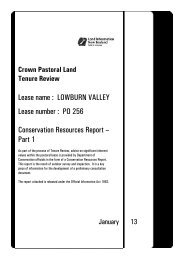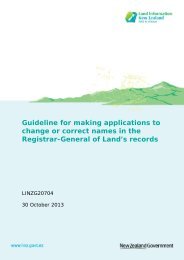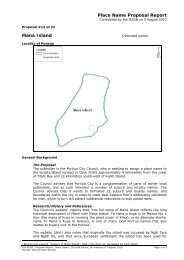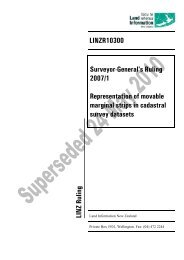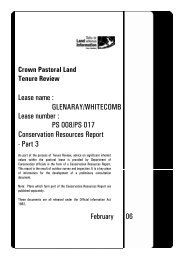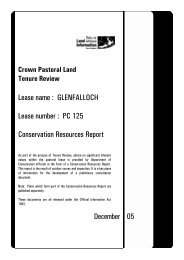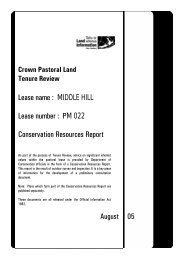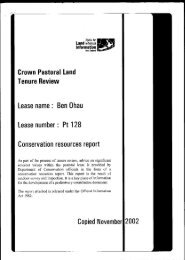Crown Pastoral-Tenure Review-Lake Hawea-Conservation ...
Crown Pastoral-Tenure Review-Lake Hawea-Conservation ...
Crown Pastoral-Tenure Review-Lake Hawea-Conservation ...
Create successful ePaper yourself
Turn your PDF publications into a flip-book with our unique Google optimized e-Paper software.
RELEASED UNDER THE OFFICIAL INFORMATION ACT<br />
Fescue tussockland of generally low naturalness extends above the shrublands on sunny<br />
faces. A reasonable belt of narrow-leaved snow tussocklands exists between 1050 – 1300 m<br />
asl, above which slim snow tussockland extends to the ridge crest at 1450 m asl.<br />
C. Breast Creek headwaters:<br />
This unit incorporates the Breast Land System (Ward loc. cit.) and comprises long undulating<br />
ridges and very extensive development of ripply colluvial slopes on the valley sides of the<br />
deeply entrenched Breast Creek.<br />
At lowest altitude are several small mountain beech forest remnants. These are confined to<br />
two main riparian locations in the south-eastern extremity of the unit; a strip approximately 1<br />
km long up Breast Creek from the most eastern extent of the property and similar length strip<br />
further up the main stem near the hut. These have a sparse understorey of occasional<br />
mingimingi, mountain wineberry and false beech (Gaultheria antipoda), with a ground cover<br />
of tussock hawkweed and wall lettuce (Mycelis muralis). The red mistletoe is a common<br />
hemi-parasite on its beech host.<br />
Small alluvial terraces exist along the larger water courses. These drought prone sandy soils<br />
support a rich herb and sub-shrub flora. Dominant species are Gaultheria parvula, Coprosma<br />
perpusilla, patotara (Leucopogon fraseri) and mouse-ear hawkweed (Hieracium pilosella).<br />
Other common species include Acaena saccaticupula, Geranium sessiliflorum, Raoulia<br />
australis, blue tussock, harebell (Wahlenbergia albomarginata), Scleranthus uniflorus,<br />
Muehlenbeckia axillaris, tussock hawkweed and King devil hawkweed (Hieracium<br />
praealtum).<br />
Extensive riparian shrublands are present along most of the main stem of Breast Creek and<br />
many of its tributaries. These have been less affected by past fires than other matagouri<br />
dominated shrublands of the slopes, and are consequently quite diverse. While matagouri is<br />
still an important structural component, other major species include mingimingi, mountain<br />
wineberry, desert broom, porcupine shrub, koromiko, Olearia odorata and Hebe subalpina.<br />
Common understorey and fringing species include thousand-leaved fern (Hypolepis<br />
millefolium), wall lettuce, Carex coriacea, C. petriei, Senecio quadridentatus, pohuehue and<br />
Clematis marata. Occasional shrub weeds are bittersweet (Solanum dulcamara) and<br />
gooseberry (Ribes uva-crispa).<br />
Two areas of riparian shrubland are of special note. One at the uppermost major fork of<br />
Breast Creek, and the other below the beech forest remnant and hut mentioned above, contain<br />
significant populations of the threatened shrub Hebe cupressoides. All age/size classes are<br />
represented, from seedlings a few centimetres tall to adults with a canopy spread exceeding<br />
four metres.<br />
Many other shrublands not associated with waterways, are also present. These include:<br />
(a) Seral matagouri-dominated shrublands overtopping tall tussock at low altitude,<br />
present on north-facing slopes<br />
(b) Coprosma ciliata/Melicytus alpinus dominated shrublands fringing blocky screes<br />
(c) Dracophyllum dominated shrublands on south-facing slopes at higher altitude (above<br />
1000 m)<br />
(d) Kanuka shrubland at low altitude on north-facing slopes<br />
DOCDM-372005 <strong>Lake</strong> <strong>Hawea</strong> CRR - Info.doc 14



